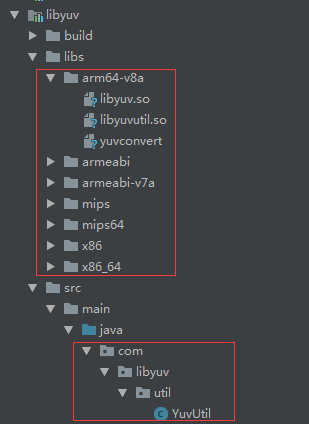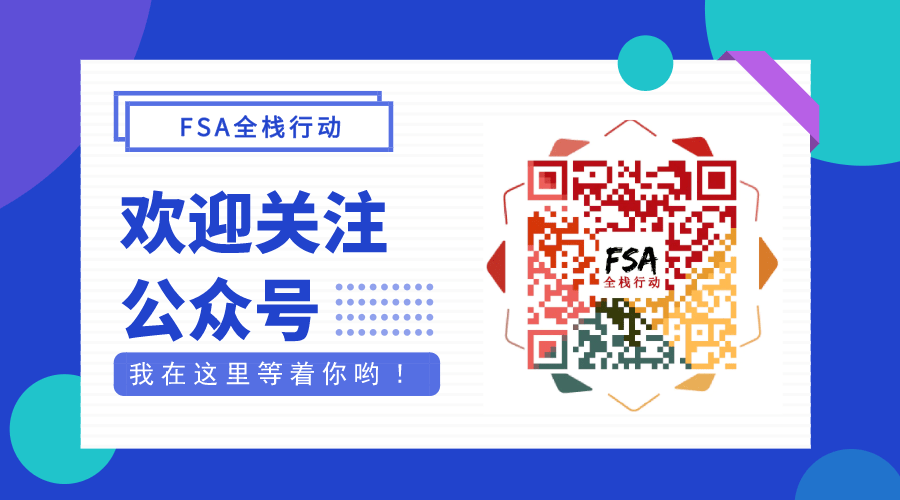《Android 音视频——Libyuv 使用实战》。该库对 libyuv 进行封装,用于处理摄像头 yuv 图像数据。
该库已发布 jitpack ,最新版本号为 
implementation 'com.github.GitLqr:LQRLibyuv:1.0.0'注:因为 jitpack 只支持使用高版本 NDK 编译(22.1.7171670),无法编译出已经淘汰的 armeabi 与 mips 架构的 so 库,所以如果有需要,请 clone 该仓库,改用低版本的 NDK 自己本地编译吧,gradle 里都写好了。
Rebuild Project后,提取 so 库与 YuvUtil.java,放到自己的工程项目中,如下图所示:
/**
* 使用YuvUtil完全手动处理YUV图像数据,要求理解byte[]的创建长度:
* yuvNV21ToI420():nv21转i420
* yuvMirrorI420():镜像
* yuvScaleI420():缩放
* yuvCropI420():裁剪
* yuvRotateI420():旋转
* yuvI420ToNV21():i420转nv21
*
* @param data 摄像头获取到的nv21数据
*/
private void yuvProcessAndDraw1(byte[] data) {
int width = WIDTH;
int height = HEIGHT;
// nv21 --> i420
byte[] nv21Data = data;
byte[] i420Data = new byte[width * height * 3 / 2];
YuvUtil.yuvNV21ToI420(nv21Data, width, height, i420Data);
// 镜像
byte[] i420MirrorData = new byte[width * height * 3 / 2];
YuvUtil.yuvMirrorI420(i420Data, width, height, i420MirrorData);
i420Data = i420MirrorData;
// 缩放
byte[] i420ScaleData = new byte[width * height * 3 / 2];
int scaleWidth = 320;
int scaleHeight = 240;
YuvUtil.yuvScaleI420(i420Data, width, height, i420ScaleData, scaleWidth, scaleHeight, 0);
i420Data = i420ScaleData;
width = scaleWidth;
height = scaleHeight;
// 裁剪
byte[] i420CropData = new byte[width * height * 3 / 2];
int cropWidth = 240;
int cropHeight = 240;
YuvUtil.yuvCropI420(i420Data, width, height, i420CropData, cropWidth, cropHeight, 0, 0);
i420Data = i420CropData;
width = cropWidth;
height = cropHeight;
// 旋转
byte[] i420RotateData = new byte[width * height * 3 / 2];
int degree = 90;
YuvUtil.yuvRotateI420(i420Data, width, height, i420RotateData, degree);
i420Data = i420RotateData;
if (degree == 90 || degree == 270) {
int temp = width;
width = height;
height = temp;
}
// i420 --> nv21
YuvUtil.yuvI420ToNV21(i420Data, width, height, nv21Data);
// 绘制图像
drawSurfaceView(data, width, height);
}/**
* 使用YuvUtil半自动处理YUV图像数据:
* yuvCompress():nv21转i420、镜像、缩放、旋转
* yuvCropI420():裁剪
* yuvI420ToNV21():i420转nv21
*
* @param data 摄像头获取到的nv21数据
*/
private void yuvProcessAndDraw2(byte[] data) {
int width = WIDTH;
int height = HEIGHT;
int dstWidth = 320;
int dstHeight = 240;
// nv21 --> i420 --> 镜像 --> 缩放 --> 旋转
byte[] nv21Data = data;
byte[] i420Data = new byte[dstWidth * dstHeight * 3 / 2];
int degree = 90;
YuvUtil.yuvCompress(nv21Data, width, height, i420Data, dstWidth, dstHeight, 0, 90, true);
// 旋转过后,需要手动校正宽高
if (degree == 90 || degree == 270) {
width = dstHeight;
height = dstWidth;
} else {
width = dstWidth;
height = dstHeight;
}
// 裁剪
byte[] i420CropData = new byte[width * height * 3 / 2];
int cropWidth = 240;
int cropHeight = 240;
YuvUtil.yuvCropI420(i420Data, width, height, i420CropData, cropWidth, cropHeight, 0, 0);
i420Data = i420CropData;
width = cropWidth;
height = cropHeight;
// i420 --> nv21
YuvUtil.yuvI420ToNV21(i420Data, width, height, nv21Data);
// 绘制图像
drawSurfaceView(data, width, height);
}/**
* 使用SurfaceView绘制Bitmap图像
* @param data nv21数据
* @param width 图像宽
* @param height 图像高
*/
private void drawSurfaceView(byte[] data, int width, int height) {
YuvImage yuvImage = new YuvImage(data, ImageFormat.NV21, width, height, null);
ByteArrayOutputStream out = new ByteArrayOutputStream();
yuvImage.compressToJpeg(new Rect(0, 0, width, height), 100, out);
byte[] bytes = out.toByteArray();
Bitmap bitmap = BitmapFactory.decodeByteArray(bytes, 0, bytes.length);
mCameraViewR.drawBitmap(bitmap);
}文章:《Android 音视频——Libyuv 使用实战》
感谢:该库基于LibyuvDemo,修复了 bug,并添加了一些新 api,感谢原作者的开源。
- YuvUtil#yuvNV21ToI420AndRotate(byte[] nv21Src, int width, int height, byte[] i420Dst, int degree);
- YuvUtil#yuvI420ToRGB24(byte[] i420Src, int width, int height, byte[] rgb24Dst);
- YuvUtil#yuvI420ToARGB(byte[] i420Src, int width, int height, int dst_stride, byte[] argbDst);
- YuvUtil#yuvI420ToRGBAMac(byte[] i420Src, int width, int height, int dst_stride, byte[] rgbaMacDst);
- YuvUtil#yuvI420ToARGB4444(byte[] i420Src, int width, int height, int dst_stride, byte[] argb4444Dst);
- YuvUtil#yuvI420ToRGB565(byte[] i420Src, int width, int height, byte[] rgb565Dst);
- YuvUtil#yuvI420ToRGB565Android(byte[] i420Src, int width, int height, byte[] rgb565Dst);
- YuvUtil#yuvI420ToARGB1555(byte[] i420Src, int width, int height, int dst_stride, byte[] argb1555Dst);
- YuvUtil#yuvI420ToYUY2(byte[] i420Src, int width, int height, int dst_stride, byte[] yuy2Dst);
- YuvUtil#yuvI420ToUYVY(byte[] i420Src, int width, int height, int dst_stride, byte[] uyvyDst);
- YuvUtil#yuvI420ToYV12(byte[] i420Src, int width, int height, int dst_stride, byte[] yv12Dst);
- YuvUtil#yuvYV12ToI420(byte[] yv12Src, int width, int height, byte[] i420Dst);
- YuvUtil#yuvNV12ToI420(byte[] nv12Src, int width, int height, byte[] i420Dst);
- YuvUtil#yuvI420ToNv12(byte[] i420Src, int width, int height, byte[] nv12Dst);
- YuvUtil#yuvNV12ToI420AndRotate(byte[] nv12Src, int width, int height, byte[] i420Dst, int degree);
- YuvUtil#yuvNV12ToRGB565(byte[] nv12Src, int width, int height, byte[] rgb565Dst);
- YuvUtil#yuvI420ToRGBAIPhone(byte[] i420Src, int width, int height, int dst_stride, byte[] rgbaDst);
- YuvUtil#yuvI420Copy(byte[] i420Src, int width, int height, int dst_stride, byte[] i420Dst);
- YuvUtil#yuvUYVYToI420(byte[] uyvySrc, int width, int height, byte[] i420Dst);
- YuvUtil#yuvYUY2ToI420(byte[] yuy2Src, int width, int height, byte[] i420Dst);
- YuvUtil#yuvRGB24ToARGB(byte[] rgb24Src, int width, int height, int dst_stride, byte[] argbDst);
- YuvUtil#yuvRGB24ToI420(byte[] rgb24Src, int width, int height, byte[] i420Dst);
- YuvUtil#yuvI420ToARGBMac(byte[] i420Src, int width, int height, int dst_stride, byte[] argbMacDst);
- YuvUtil#yuvARGBMacToI420(byte[] argbMacSrc, int width, int height, byte[] i420Dst);
- YuvUtil#yuvMirrorI420LeftRight(byte[] i420Src, int width, int height, byte[] i420Dst);
- YuvUtil#yuvMirrorI420UpDown(byte[] i420Src, int width, int height, byte[] i420Dst);

